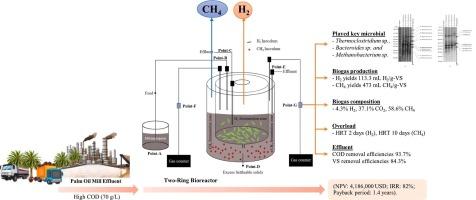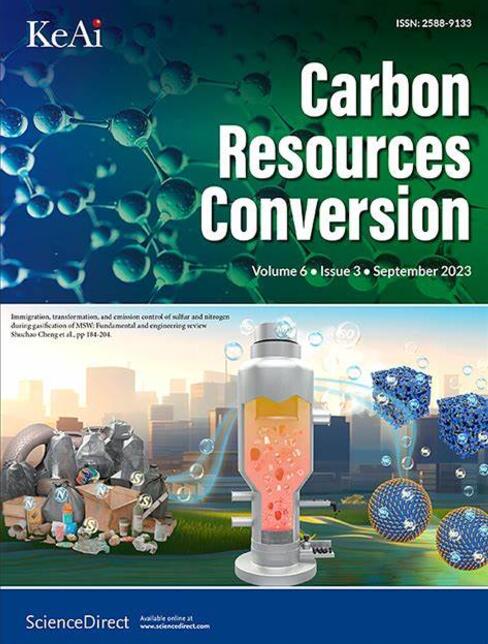热厌氧菌PSU-2和产甲烷混合培养在嗜热双环生物反应器中提高棕榈油厂废水中生物乙烷的产量
IF 7.5
3区 环境科学与生态学
Q2 ENERGY & FUELS
引用次数: 0
摘要
采用一种新型的嗜热双环生物反应器,利用嗜热厌氧菌PSU-2和嗜热产甲烷菌混合培养物从棕榈油厂废水中生产生物乙烷。该反应器系统表现出令人印象深刻的性能,氢气和甲烷的产率分别为113.3±15.0 mL/g-VS和473.0±60.0 mL/g-VS,总生物乙烷组成为4.3% H2, 37.1% CO2和58.6% CH4。该工艺处理效果良好,COD去除率达93.7%,VS去除率达84.3%。微生物群落分析揭示了各种微生物在生物乙烷生产过程中的重要作用。热梭菌(Thermoclostridium sp.)、热厌氧细菌(thermoanaerobobacterium sp.)和厌氧支菌(Anaerobranca sp.)是产氢的关键菌,拟杆菌(Bacteroides sp.)和甲烷细菌(Methanobacterium sp.)是产甲烷的必需菌。优化pH(5.0 ~ 8.0)、温度(55℃)、水力滞留时间(H2滞留2 d、CH4滞留10 d),显著提高了生物乙烷的生产效率。技术经济分析表明,该亲热双环生物反应器系统具有经济可行性,净现值为418.6万美元,内部收益率为82%,投资回收期为1.4年。这些发现突出表明,这一创新技术具有潜力,可以作为一种可持续的、经济上具有吸引力的解决方案,用于处理POME,同时以生物乙烷的形式生产可再生能源,有助于棕榈油工业的可持续发展和减少温室气体排放。本文章由计算机程序翻译,如有差异,请以英文原文为准。

Enhancement of biohythane production from palm oil mill effluent by Thermoanaerobacterium thermosaccharolyticum PSU-2 and methanogenic mixed cultures using a thermophilic two-ring bioreactor
A novel thermophilic two-ring bioreactor was employed to produce biohythane from palm oil mill effluent (POME) using Thermoanaerobacterium thermosaccharolyticum PSU-2 and thermophilic methanogenic mixed cultures. The reactor system demonstrated impressive performance, achieving hydrogen and methane yields of 113.3 ± 15.0 mL/g-VS and 473.0 ± 60.0 mL/g-VS, respectively, with a total biohythane composition of 4.3 % H2, 37.1 % CO2, and 58.6 % CH4. The process exhibited high treatment efficiency, with COD and VS removal efficiencies reaching 93.7 % and 84.3 %, respectively. Microbial community analysis revealed the crucial roles of various microorganisms in the biohythane production process. Thermoclostridium sp., Thermoanaerobacterium sp., and Anaerobranca sp. were identified as key players in hydrogen production, while Bacteroides sp. and Methanobacterium sp. were found to be essential for methane production. The optimization of operating conditions, including pH (5.0–8.0), temperature (55 °C), and hydraulic retention time (2 d for H2 and 10 d for CH4), significantly enhanced biohythane production efficiency. The techno-economic analysis demonstrated the economic viability of the thermophilic two-ring bioreactor system, with a net present value of 4,186,000 USD, an internal rate of return of 82 %, and a payback period of 1.4 years. These findings highlight the potential of this innovative technology as a sustainable and economically attractive solution for treating POME and simultaneously producing renewable energy in the form of biohythane, contributing to the sustainable development of the palm oil industry and the mitigation of greenhouse gas emissions.
求助全文
通过发布文献求助,成功后即可免费获取论文全文。
去求助
来源期刊

Carbon Resources Conversion
Materials Science-Materials Science (miscellaneous)
CiteScore
9.90
自引率
11.70%
发文量
36
审稿时长
10 weeks
期刊介绍:
Carbon Resources Conversion (CRC) publishes fundamental studies and industrial developments regarding relevant technologies aiming for the clean, efficient, value-added, and low-carbon utilization of carbon-containing resources as fuel for energy and as feedstock for materials or chemicals from, for example, fossil fuels, biomass, syngas, CO2, hydrocarbons, and organic wastes via physical, thermal, chemical, biological, and other technical methods. CRC also publishes scientific and engineering studies on resource characterization and pretreatment, carbon material innovation and production, clean technologies related to carbon resource conversion and utilization, and various process-supporting technologies, including on-line or off-line measurement and monitoring, modeling, simulations focused on safe and efficient process operation and control, and process and equipment optimization.
 求助内容:
求助内容: 应助结果提醒方式:
应助结果提醒方式:


